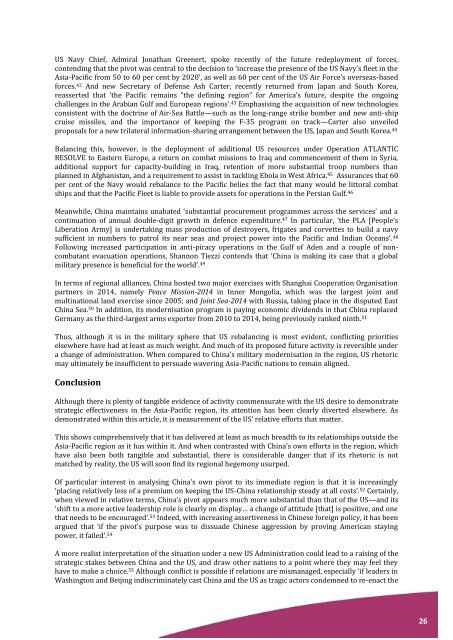Issue No 198 2015
198 2015 Nov_Dec
198 2015 Nov_Dec
Create successful ePaper yourself
Turn your PDF publications into a flip-book with our unique Google optimized e-Paper software.
US Navy Chief, Admiral Jonathan Greenert, spoke recently of the future redeployment of forces,<br />
contending that the pivot was central to the decision to ‘increase the presence of the US Navy’s fleet in the<br />
Asia-Pacific from 50 to 60 per cent by 2020’, as well as 60 per cent of the US Air Force’s overseas-based<br />
forces. 42 And new Secretary of Defense Ash Carter, recently returned from Japan and South Korea,<br />
reasserted that ‘the Pacific remains “the defining region” for America’s future, despite the ongoing<br />
challenges in the Arabian Gulf and European regions’. 43 Emphasising the acquisition of new technologies<br />
consistent with the doctrine of Air-Sea Battle—such as the long-range strike bomber and new anti-ship<br />
cruise missiles, and the importance of keeping the F-35 program on track—Carter also unveiled<br />
proposals for a new trilateral information-sharing arrangement between the US, Japan and South Korea. 44<br />
Balancing this, however, is the deployment of additional US resources under Operation ATLANTIC<br />
RESOLVE to Eastern Europe, a return on combat missions to Iraq and commencement of them in Syria,<br />
additional support for capacity-building in Iraq, retention of more substantial troop numbers than<br />
planned in Afghanistan, and a requirement to assist in tackling Ebola in West Africa. 45 Assurances that 60<br />
per cent of the Navy would rebalance to the Pacific belies the fact that many would be littoral combat<br />
ships and that the Pacific Fleet is liable to provide assets for operations in the Persian Gulf. 46<br />
Meanwhile, China maintains unabated ‘substantial procurement programmes across the services’ and a<br />
continuation of annual double-digit growth in defence expenditure. 47 In particular, ‘the PLA [People’s<br />
Liberation Army] is undertaking mass production of destroyers, frigates and corvettes to build a navy<br />
sufficient in numbers to patrol its near seas and project power into the Pacific and Indian Oceans’. 48<br />
Following increased participation in anti-piracy operations in the Gulf of Aden and a couple of noncombatant<br />
evacuation operations, Shannon Tiezzi contends that ‘China is making its case that a global<br />
military presence is beneficial for the world’. 49<br />
In terms of regional alliances, China hosted two major exercises with Shanghai Cooperation Organisation<br />
partners in 2014, namely Peace Mission-2014 in Inner Mongolia, which was the largest joint and<br />
multinational land exercise since 2005; and Joint Sea-2014 with Russia, taking place in the disputed East<br />
China Sea. 50 In addition, its modernisation program is paying economic dividends in that China replaced<br />
Germany as the third-largest arms exporter from 2010 to 2014, being previously ranked ninth. 51<br />
Thus, although it is in the military sphere that US rebalancing is most evident, conflicting priorities<br />
elsewhere have had at least as much weight. And much of its proposed future activity is reversible under<br />
a change of administration. When compared to China’s military modernisation in the region, US rhetoric<br />
may ultimately be insufficient to persuade wavering Asia-Pacific nations to remain aligned.<br />
Conclusion<br />
Although there is plenty of tangible evidence of activity commensurate with the US desire to demonstrate<br />
strategic effectiveness in the Asia-Pacific region, its attention has been clearly diverted elsewhere. As<br />
demonstrated within this article, it is measurement of the US’ relative efforts that matter.<br />
This shows comprehensively that it has delivered at least as much breadth to its relationships outside the<br />
Asia-Pacific region as it has within it. And when contrasted with China’s own efforts in the region, which<br />
have also been both tangible and substantial, there is considerable danger that if its rhetoric is not<br />
matched by reality, the US will soon find its regional hegemony usurped.<br />
Of particular interest in analysing China’s own pivot to its immediate region is that it is increasingly<br />
‘placing relatively less of a premium on keeping the US-China relationship steady at all costs’. 52 Certainly,<br />
when viewed in relative terms, China’s pivot appears much more substantial than that of the US—and its<br />
‘shift to a more active leadership role is clearly on display… a change of attitude [that] is positive, and one<br />
that needs to be encouraged’. 53 Indeed, with increasing assertiveness in Chinese foreign policy, it has been<br />
argued that ‘if the pivot’s purpose was to dissuade Chinese aggression by proving American staying<br />
power, it failed’. 54<br />
A more realist interpretation of the situation under a new US Administration could lead to a raising of the<br />
strategic stakes between China and the US, and draw other nations to a point where they may feel they<br />
have to make a choice. 55 Although conflict is possible if relations are mismanaged, especially ‘if leaders in<br />
Washington and Beijing indiscriminately cast China and the US as tragic actors condemned to re-enact the<br />
26


